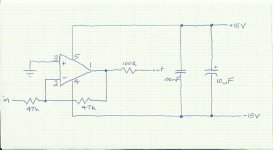Hi all.
I am fairly new to DIY audio, so please bear with me! 🙂
I have decided to tackle a preamp as my first design/project. The idea is to have a ladder-type step attenuator going into an opamp buffer. The attenuator, which I already have, is 10k. I'm planning on using a LM4562 opamp in the buffer.
Hifi setup is:
Arcam Alpha 7 CDP (Zout = 150R) -> preamp -> Rotel RB-1070 (Zin = 33k)
All cables are 65 ohm, 67pF coaxial.
I'm posting the schematic I've done for the buffer (one channel shown). I wonder if I could prevail upon your collective wisdom to answer a few questions.
1. Does the 47k input resistor interact with the attenuator in terms of Zin for the preamp as a whole?
2. Is the 100R output resistor necessary? I've basically included it because other schematics I've seen have something similar. I'm assuming it's there for drive current reasons. Opamp Iout is rated at 26mA into 600 ohms.
3. Should I use coupling caps on the outputs? Opamp offset voltage is 100uV max.
4. Is the buffer even necessary with the 10k attenuator?
I am fairly new to DIY audio, so please bear with me! 🙂
I have decided to tackle a preamp as my first design/project. The idea is to have a ladder-type step attenuator going into an opamp buffer. The attenuator, which I already have, is 10k. I'm planning on using a LM4562 opamp in the buffer.
Hifi setup is:
Arcam Alpha 7 CDP (Zout = 150R) -> preamp -> Rotel RB-1070 (Zin = 33k)
All cables are 65 ohm, 67pF coaxial.
I'm posting the schematic I've done for the buffer (one channel shown). I wonder if I could prevail upon your collective wisdom to answer a few questions.
1. Does the 47k input resistor interact with the attenuator in terms of Zin for the preamp as a whole?
2. Is the 100R output resistor necessary? I've basically included it because other schematics I've seen have something similar. I'm assuming it's there for drive current reasons. Opamp Iout is rated at 26mA into 600 ohms.
3. Should I use coupling caps on the outputs? Opamp offset voltage is 100uV max.
4. Is the buffer even necessary with the 10k attenuator?
Attachments
A buffer is necessary if the capacitive load on the 10k attenuator results in impared HF performance.
The 100r on the output is a good addition.
The 100nF decoupling must be on pins 5 & 4. Are you pin numbers correct (8+ & 4-)? On a quick scan, I could not find the decoupling recommendation.
The sch is an inverting amplifier.
The gain is 47k/[47k+Rs] = 1 = +0dB if the Rs is zero. Added Rs give extra attenuation in addition to the attenuator.
The Zin is 47k // to cable capacitance.
The output offset will be much bigger than 100uVdc. This is because the input offset currents see different resistances @ the +IN (0r0) and -IN (47k//47k = 23k5) inputs. expect <1.6mVdc
The 100r on the output is a good addition.
The 100nF decoupling must be on pins 5 & 4. Are you pin numbers correct (8+ & 4-)? On a quick scan, I could not find the decoupling recommendation.
The sch is an inverting amplifier.
The gain is 47k/[47k+Rs] = 1 = +0dB if the Rs is zero. Added Rs give extra attenuation in addition to the attenuator.
The Zin is 47k // to cable capacitance.
The output offset will be much bigger than 100uVdc. This is because the input offset currents see different resistances @ the +IN (0r0) and -IN (47k//47k = 23k5) inputs. expect <1.6mVdc
Thanks AndrewT.
First of all - yes, I had the pin numbers screwed up. My bad!
Thanks for your reply. I've learned quite a bit from it. I'll have to go back to the drawing board I think - and read up some more on exactly how these opamp doodads work!
First of all - yes, I had the pin numbers screwed up. My bad!
Thanks for your reply. I've learned quite a bit from it. I'll have to go back to the drawing board I think - and read up some more on exactly how these opamp doodads work!
There are a couple of good books on op-amp applications such as "Op amps for everyone" and sections in the audio electronics texts like Douglas Self's on Small Signal Audio Design. If you don't wan't to spend on books or rely on the device application notes, this download of Walt Jung's classic (or chapters from it) might suit you. Good reading!
ADI - Analog Dialogue | Op Amp Applications Handbook
ADI - Analog Dialogue | Op Amp Applications Handbook
- Status
- Not open for further replies.
